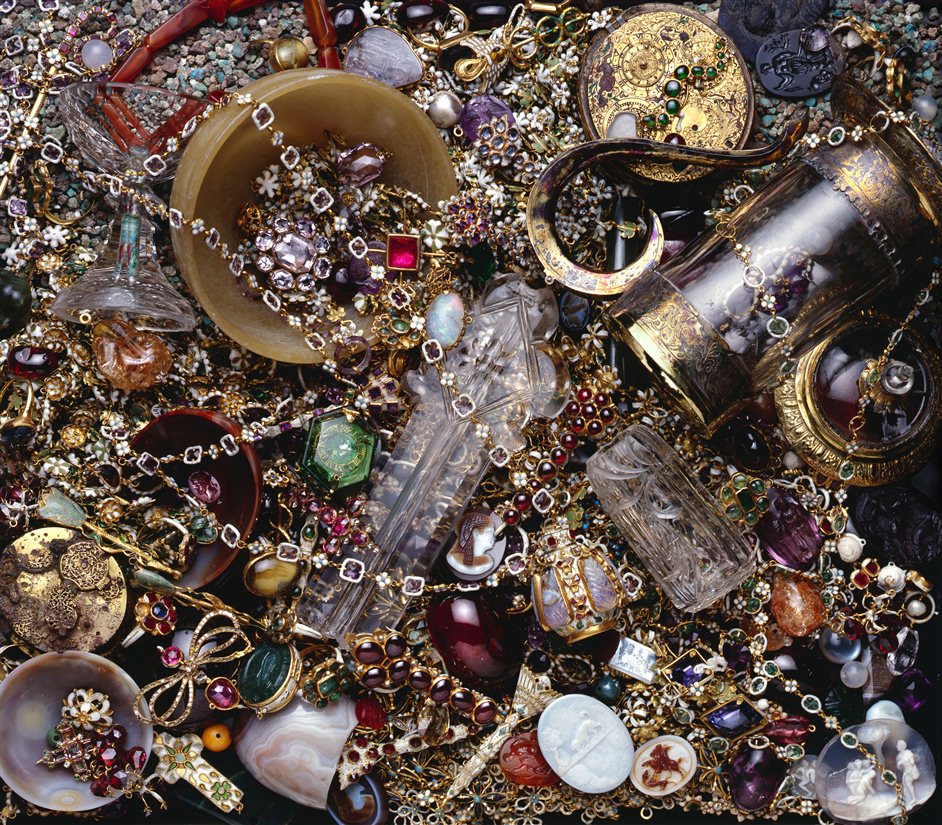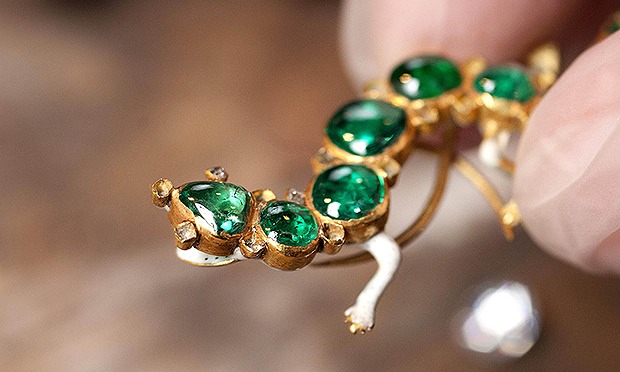
Here at The Ministry we often visit exhibitions together yet rarely review them as one, but when it came to Museum of London’s latest blockbuster ‘Cheapside Hoard: London’s Lost Jewels’ we had too much to say for ourselves so why not reveal our critical personalities and combine our assessments into one post for the first time ever!
Terri says...
‘The mysteries that remain, lost
among the cataclysmic events of the mid- 17th Century: who owned the Hoard, when and
why was it hidden, and why was it never reclaimed’ – Museum of London.
What is so significant about the
Cheapside Hoard? The mystery of why and who buried the collection of jewellery
in the seventeenth century is a key theme of the hoard’s history and its
current exhibition at the Museum of London. Who owned the hoard? Why was it
hidden? And why did the owner never return to claim it? Opinion is varied yet
one story predominates; in some sort of a hurry a jeweller buried his working
collection containing rings, brooches, necklaces, gemstones expecting to
return. Regardless of the jeweller's personal life and absence due to
Elizabethan drama/death the hoard provides the most fantastic examples of 16th and 17th century craftsmanship and consumption.
Filled with Jacobean and
Elizabethan treasures the simple wooden box of sparkling and shiny jewellery
was unearthed at the City of London’s Cheapside in 1912. Cheapside was
considered the Hatton Gardens of its day, occupied by jewellers, markets,
dealers the area even provided a site of pageantry for Elizabeth I the day
before her coronation in 1599. Beneath the commercial hub of the City the hoard
was left untouched for hundreds of years, until a high priced game of Finders
Keepers when workmen evacuating a cellar unearthed the cache. The lucky sods soon
sold all of their loot to ‘Stony Jack’ a notorious antiques dealer and
‘Inspector of Excavations’ for the London Museum, who then sold it majority to
the London Museum, a few pieces to the British Museum and one chain to the
V&A
The Museum of London’s exhibition
‘Cheapside Hoard: London’s lost jewels’ is the first time in since that sale in
1912 that the entirety of the hoard has been displayed together. The sheer
amount of sparkle makes the show a ‘must see’ but what does it contents tell
us?
Jacobean and Elizabethan London
was a site of conspicuous consumption, with the birth of travel and overseas
trade in the sixteenth century London was becoming a notorious site of
consumerism – that has lasted until today. The rich were getting richer and a
new middling merchant class was emerging. With this, the dramatic effect of
status loomed heavy among those merchant classes and upper parts of
society. A need to prove wealth and standing and what better way was there than
to adorn oneself in jewellery. The more exotic to show travel and the larger
quantity to show wealth equaled a theatrical need to express who you are by
what you were consuming.
The sheer amount of examples is
thrilling yet it is surprising to hear that the curator of the exhibition Hazel Forsyth believes that many of the
treasures are still out there, Citing stories of ex- London Museum workers
bringing back the odd ring or brooch as they leave the institution coupled with
the 1912’s workmen’s fondness for a few drinks. Are there more treasures to be exhumed
from the Cheapside Hoard?
 |
| If only my jewellery box looked like this... |
Kristin says...
With objects like these, you can be damn sure that Museum of London is expecting Cheapside Hoard to be its blockbuster exhibition of the year. And in true MoL style, the exhibition design matches the theme of ostentation. Entering the exhibition, you will be expected to leave all your belongings behind and pass through barred doors that make you feel like you are entering the Bank of England. Security procedure or exhibition design? Unclear, but the effect is amazing. It’s almost difficult to read the introductory text panel you are so distracted by a lighted sculpture of precious jewels hung from exposed wood beams. The beginning contextualising displays are, thankfully, blocked from the rest of the exhibition because if you knew what was coming next you would probably be spending considerably less time examining that painting. Around the corner is a reproduction jeweller's shop and once you make it past there, well, jewellery bonanza.
The sheer scale of the hoard is brought together in one
large room where you can circulate around the cases examining the minute
details of each piece using your own spy-glass. On the one hand it brings an
interactive element to an otherwise quite distant exhibition of expensive
jewellery, but on the other hand it’s necessary as each item is so minute.
Despite the very exciting subject matter, I don’t really envy the person who
had to plan out a major exhibition based only on incredibly intricate 17th
century jewellery. But with beautiful high resolution videos, complementary textiles
and paintings and your trust magnifying glass, it all feels way more
accessible.
As it should be in an exhibition about the beauty of small
things, it is the little touches that really makes the exhibition design a
stand out. Contemporary shop signs actually hung at their proper height make a
great change from the way such objects are normally displayed. What is really
quite an average looking wooden carving seems ominous and somehow more real
mounted above the rest of the displays. Someone on the exhibition team has even
thought to push for tactile replicas which you can covet as you examine the
real thing close up. Who said that an exhibition about jewellery had to be
fiddly?
If we could fault the exhibition on any front it would be
the video at the end. Why have they found it necessary to commission a dramatic
video that expounds the secrets of the hoard and very tenuously tries to link
it to modern life? We came for the shiny things, you gave us the shiny things,
and we are pleased.



No comments:
Post a Comment